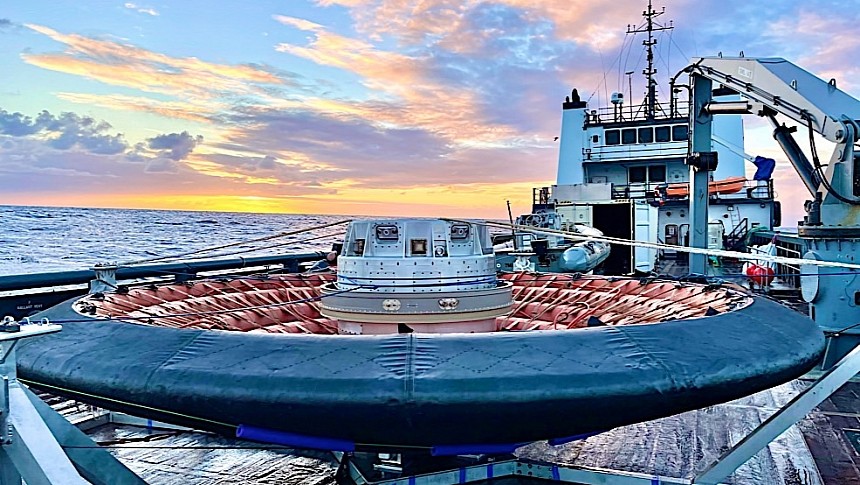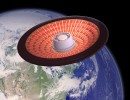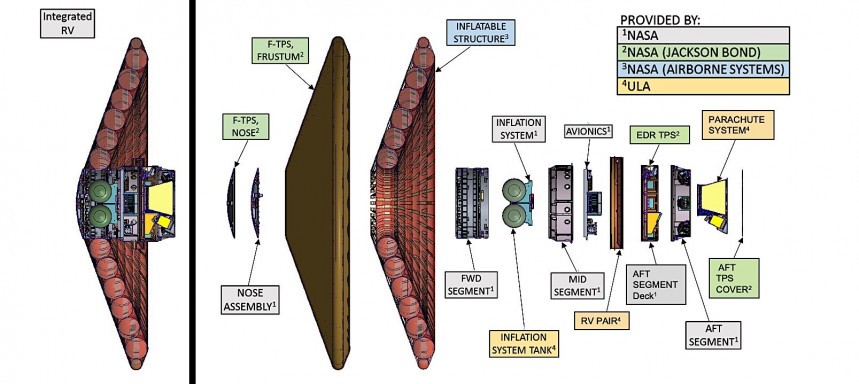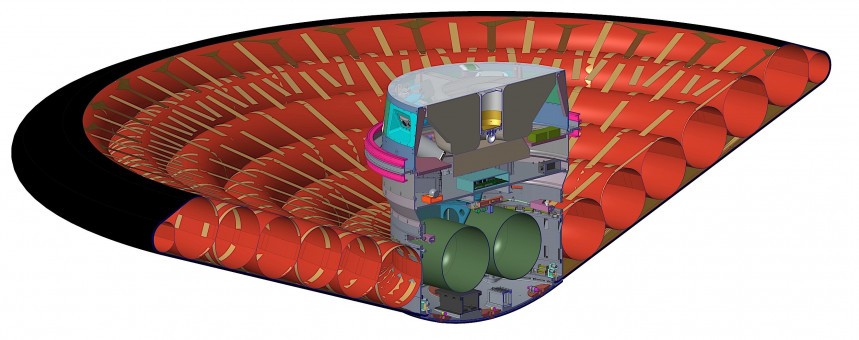Back on November 10, 2022, some of you might have caught glimpses of a screaming ball of fire dropping from the sky. It wasn't an asteroid, or some satellite gone rogue, but a piece of technology the American space agency calls the LOFTID.
The word is an acronym for Low-Earth Orbit Flight Test of an Inflatable Decelerator, and in essence it stands to represent a new approach to spacecraft heat shields – you know, that piece of hardware meant to protect a space vehicle as it makes its fiery re-entry in a planet's atmosphere.
Heat shields are crucial in ensuring the survival of spacecraft and the people and hardware during re-entry. In most places of this solar system, coming down from space to the surface entails surviving extreme conditions.
Take one of the most recent spacecraft to do that, the Perseverance rover. The thing was delivered to the surface of Mars by means of a lander equipped with a heat shield. It had to survive 2,550 degrees Fahrenheit (1,400 degrees Celsius) of heat on its way down, and thanks to the materials used to coat its exterior, it did.
So did the Orion spacecraft that recently conducted the first Artemis mission at the end of last year. Because it came back from the Moon to a much thicker atmosphere than the one on Mars, its heatshield had to survive temperatures twice as high as molten lava: 5,000 degrees Fahrenheit (2,760 Celsius). And it did too, while keeping the atmosphere inside the Orion at a cool 70 degrees Fahrenheit (21 degrees Celsius).
Generally speaking, although they are quite effective, present-day heat shields do have limitations, especially when looking ahead at the missions planned to target places like Mars, Venus, or the Saturn moon Titan. And two of the main limitations have to do with the fact they are fixed, unmovable pieces of hardware, and their size depends greatly on the size of the size of the spacecraft's shroud.
LOFTID is essentially an inflatable heat shield that occupies a lot less space when not fully deployed, meaning it could technically fit all sorts of spacecraft. And we now know it works just as advertised, as the test concluded last year recently came under the scrutiny of the Langley Research Center, and the people there declared themselves more than satisfied with the results.
Last week NASA released some of the results of this scrutiny, and thanks to them we can now have a more intimate look of what the test was all about.
LOFTID launched aboard a United Launch Alliance (ULA) Atlas V rocket, and in it's compressed state it measured just 1.2 meters (4 feet) in diameter. When it unfolded, though, it reached a staggering 6 meters (20 feet) in diameter, beating the previous record holder, the Mars Science Laboratory, by a significant margin (that one was just 4.5 meters/14 feet in diameter).
The deployment of the shield went without a hitch, and on its way down LOFTID became the largest blunt body ever to reenter Earth's atmosphere. And it was quite a sight to behold, too, if you could catch it in the sky: it came down at speeds of over 18,000 mph (29,000 kph), eating itself up to 2,700 degrees Fahrenheit (1,482 degrees Celsius). When it was all over, the piece of hardware was recovered from the Pacific Ocean.
Despite all these horrible conditions, the team that looked at the shield found it "appeared pristine, with minimal damage, meaning its performance was […] just flawless."
There is one thing about last year's test that still has NASA people scrambling to figure out. Do you all know how the extreme heat of re-entry makes the gases around a spacecraft ionize and turn into orange plasma? Well, it seems in the LOFTID test that orange plasma changed color to purple.
It's unclear why that is so, and this little mystery, as per LOFTID chief engineer John DiNonno, is still being investigated.
Now that the first flight of the new shield design is over, NASA is looking to develop one that's twice the size, 12 meters (40 feet). This one will be flown as a means to protect ULA's Vulcan engines and get them primed for re-use.
The size of this shield may seem exaggerated, but it is exactly this attribute that could help it slow down faster and at a higher altitude.
If successful, the heat shield may become commonplace on both NASA's and partner companies' spacecraft, and its uses might be expanded to include small satellite reentry, aerocapture, and cislunar payloads.
NASA and its partners also refer to the LOFTID as the Hypersonic Inflatable Aerodynamic Decelerator (HIAD) aeroshell, because that's the name used on two previous subscale prototypes. No matter how you call it, it remains unclear when we are to expect a fully mature technology, as the agency gave no timetable for the shield's development.
Heat shields are crucial in ensuring the survival of spacecraft and the people and hardware during re-entry. In most places of this solar system, coming down from space to the surface entails surviving extreme conditions.
Take one of the most recent spacecraft to do that, the Perseverance rover. The thing was delivered to the surface of Mars by means of a lander equipped with a heat shield. It had to survive 2,550 degrees Fahrenheit (1,400 degrees Celsius) of heat on its way down, and thanks to the materials used to coat its exterior, it did.
So did the Orion spacecraft that recently conducted the first Artemis mission at the end of last year. Because it came back from the Moon to a much thicker atmosphere than the one on Mars, its heatshield had to survive temperatures twice as high as molten lava: 5,000 degrees Fahrenheit (2,760 Celsius). And it did too, while keeping the atmosphere inside the Orion at a cool 70 degrees Fahrenheit (21 degrees Celsius).
Generally speaking, although they are quite effective, present-day heat shields do have limitations, especially when looking ahead at the missions planned to target places like Mars, Venus, or the Saturn moon Titan. And two of the main limitations have to do with the fact they are fixed, unmovable pieces of hardware, and their size depends greatly on the size of the size of the spacecraft's shroud.
Last week NASA released some of the results of this scrutiny, and thanks to them we can now have a more intimate look of what the test was all about.
LOFTID launched aboard a United Launch Alliance (ULA) Atlas V rocket, and in it's compressed state it measured just 1.2 meters (4 feet) in diameter. When it unfolded, though, it reached a staggering 6 meters (20 feet) in diameter, beating the previous record holder, the Mars Science Laboratory, by a significant margin (that one was just 4.5 meters/14 feet in diameter).
The deployment of the shield went without a hitch, and on its way down LOFTID became the largest blunt body ever to reenter Earth's atmosphere. And it was quite a sight to behold, too, if you could catch it in the sky: it came down at speeds of over 18,000 mph (29,000 kph), eating itself up to 2,700 degrees Fahrenheit (1,482 degrees Celsius). When it was all over, the piece of hardware was recovered from the Pacific Ocean.
Despite all these horrible conditions, the team that looked at the shield found it "appeared pristine, with minimal damage, meaning its performance was […] just flawless."
It's unclear why that is so, and this little mystery, as per LOFTID chief engineer John DiNonno, is still being investigated.
Now that the first flight of the new shield design is over, NASA is looking to develop one that's twice the size, 12 meters (40 feet). This one will be flown as a means to protect ULA's Vulcan engines and get them primed for re-use.
The size of this shield may seem exaggerated, but it is exactly this attribute that could help it slow down faster and at a higher altitude.
If successful, the heat shield may become commonplace on both NASA's and partner companies' spacecraft, and its uses might be expanded to include small satellite reentry, aerocapture, and cislunar payloads.
NASA and its partners also refer to the LOFTID as the Hypersonic Inflatable Aerodynamic Decelerator (HIAD) aeroshell, because that's the name used on two previous subscale prototypes. No matter how you call it, it remains unclear when we are to expect a fully mature technology, as the agency gave no timetable for the shield's development.








